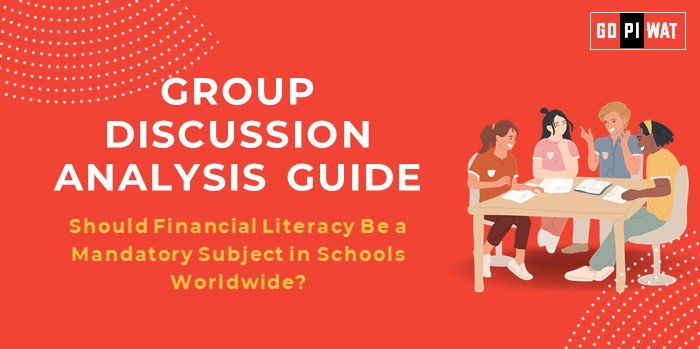📋 Group Discussion Analysis Guide: Should Financial Literacy Be a Mandatory Subject in Schools Worldwide?
🌐 Introduction to the Topic
💭 Opening Context
In a world driven by financial decisions, financial literacy is emerging as a critical life skill. As economic challenges and opportunities proliferate, equipping the younger generation with financial knowledge is no longer a luxury but a necessity.
📖 Topic Background
Financial literacy, defined as the ability to understand and effectively use various financial skills, is a global concern. While some countries have integrated it into school curriculums, others lag, raising questions about its universal implementation. The 2008 global financial crisis underscored the importance of financial literacy in mitigating economic vulnerabilities.
📊 Quick Facts and Key Statistics
- 🌍 Global Financial Literacy Rate: Only 33% of adults are financially literate (World Bank, 2023).
- 💳 Youth Debt in the US: 54% of young adults have credit card debt, highlighting the need for early financial education.
- 📘 Countries Mandating Financial Literacy: Only 21 nations include financial literacy as part of school curriculums (OECD, 2023).
- 💰 Student Loan Debt Worldwide: Over $1.7 trillion in the US alone, showcasing the impact of poor financial knowledge.
🤝 Stakeholders and Their Roles
- 🏛️ Governments: Develop policies and integrate financial literacy into national curriculums.
- 🏫 Educational Institutions: Implement programs and train educators for financial literacy.
- 💼 Financial Organizations: Provide expertise and funding for educational materials.
- 👨👩👧👦 Parents and Communities: Reinforce financial habits learned at school.
🏆 Achievements and Challenges
🌟 Achievements
- 📈 Economic Awareness: Students in countries like Finland with mandated financial literacy programs display better financial decision-making skills.
- 💳 Reduced Youth Debt: Evidence from New Zealand shows a 15% decline in youth debt after curriculum integration.
- 🌏 Cross-Cultural Success: Australia’s National Consumer and Financial Literacy Framework has seen wide adoption.
⚠️ Challenges
- 🚧 Implementation Barriers: Lack of trained educators and standardized curriculums.
- 📉 Socioeconomic Divide: Financial literacy is often inaccessible to marginalized communities.
- 🌐 Global Comparison: Countries like Japan excel in financial literacy education, while developing nations struggle due to resource constraints.
💬 Structured Arguments for Discussion
✅ Supporting Stance
“Making financial literacy mandatory prepares students for real-world financial challenges, reducing the risk of poor financial decisions.”
❌ Opposing Stance
“Financial literacy mandates might overburden schools already struggling with tight curriculums and insufficient resources.”
⚖️ Balanced Perspective
“While beneficial, implementing financial literacy must address disparities in educational resources to ensure universal effectiveness.”
🎯 Effective Discussion Approaches
🚀 Opening Approaches
- 📊 Data-Driven: “Only 33% of adults globally are financially literate. Can we afford to leave future generations unprepared?”
- 🌍 Case Study: “In Finland, mandatory financial education reduced youth debt by 20% within a decade.”
🤝 Counter-Argument Handling
“While resource limitations are valid concerns, public-private partnerships can bridge funding and expertise gaps.”
🔍 Strategic Analysis of Strengths and Weaknesses
💪 Strengths
- ✅ Enhances economic stability and personal financial health.
- ✅ Prepares students for life beyond academics.
🔻 Weaknesses
- ⚠️ Inconsistent implementation due to policy gaps.
- ⚠️ Cultural resistance in traditional education systems.
✨ Opportunities
- 📱 Technology-based learning solutions (e.g., apps, games).
- 🤝 Collaboration with financial institutions.
⚠️ Threats
- 📵 Over-reliance on technology may alienate underprivileged students.
- 💸 Resistance from stakeholders due to additional costs.
🎓 Connecting with B-School Applications
- 🌐 Real-World Applications: Understanding consumer behavior, microfinance, and investment strategies.
- 📝 Sample Interview Questions:
- 💡 “What role does financial literacy play in global economic stability?”
- 💡 “How can schools effectively integrate financial education into their curriculums?”
- 🚀 Insights for B-School Students: Early exposure to financial literacy could inspire innovative financial solutions during internships and projects.


